
95% of researchers rate our articles as excellent or good
Learn more about the work of our research integrity team to safeguard the quality of each article we publish.
Find out more
ORIGINAL RESEARCH article
Front. Chem. , 12 January 2023
Sec. Chemical Physics and Physical Chemistry
Volume 10 - 2022 | https://doi.org/10.3389/fchem.2022.1006637
This article is part of the Research Topic Electronic and Nuclear Quantum Dynamics of Molecules in Intense Laser Fields View all 13 articles
For studying any event, measurement can never be enough; “control” is required. This means mere passive tracking of the event is insufficient and being able to manipulate it is necessary. To maximize this capability to exert control and manipulate, both spatial and temporal domains need to be jointly accounted for, which has remained an intractable problem at microscopic scales. Simultaneous control of dynamics and position of an observable event requires a holistic combination of spatial and temporal control principles, which gives rise to the field of spatiotemporal control. For this, we present a novel femtosecond pulse-shaping approach. We explain how to achieve spatiotemporal control by spatially manipulating the system through trapping and subsequently or simultaneously exerting temporal control using shaped femtosecond pulses. By leveraging ultrafast femtosecond lasers, the prospect of having temporal control of molecular dynamics increases, and it becomes possible to circumvent the relaxation processes at microscopic timescales. Optical trapping is an exemplary demonstration of spatial control that results in the immobilization of microscopic objects with radiation pressure from a tightly focused laser beam. Conventional single-beam optical tweezers use continuous-wave (CW) lasers for achieving spatial control through photon fluxes, but these lack temporal control knobs. We use a femtosecond high repetition rate (HRR) pulsed laser to bypass this lack of dynamical control in the time domain for optical trapping studies. From a technological viewpoint, the high photon flux requirement of stable optical tweezers necessitates femtosecond pulse shaping at HRR, which has been a barrier until the recent Megahertz pulse shaping developments. Finally, recognizing the theoretical distinction between tweezers with femtosecond pulses and CW lasers is of paramount interest. Non-linear optical (NLO) interactions must be included prima facie to understand pulsed laser tweezers in areas where they excel, like the two-photon-fluorescence-based detection. We show that our theoretical model can holistically address the common drawback of all tweezers. We are able to mitigate the effects of laser-induced heating by balancing this with femtosecond laser-induced NLO effects. An interesting side-product of HRR femtosecond-laser-induced thermal lens is the development of femtosecond thermal lens spectroscopy (FTLS) and its ability to provide sensitive molecular detection.
For a spectroscopist, typical light-matter interactions are kept at perturbative levels, with active attempts to minimize all possible interactions with light so as to recover as much information as possible about the system under study. The experimenter is a passive observer in such studies. However, when one wants to participate in and control light-matter processes, for example, out of a desire to enhance chemical selectivity or reaction yields in photochemical processes, the passive viewer approach of a spectroscopist is not sufficient. The desire to selectively enhance chemical processes gave rise to the dream of “controlling chemistry” (Warren et al., 1993), way back in the 1960s, since the first practical demonstration of lasers.
The most general investigation and manipulation of light-induced processes require simultaneous control over temporal and spatial properties of the electromagnetic radiation on femtosecond time and nanometer length scales (Aeschlimann et al., 2010; Froula et al., 2018; Schmidt et al., 2021). Most vibrational transitions occur within a few femtoseconds, and these are responsible for chemical transformations that make new bonds and break old bonds. The coherent nature of an ultrafast pulsed laser is crucial for manipulating electronic and nuclear motions, and this gave birth to the concept of “coherent control” involving the manipulation of molecular states coherently and, therefore, circumventing the limits of the uncertainty principle for ultrashort laser pulses (Dantus and Lozovoy, 2004). Though coherent control is an exciting principle, it often involves exotic experimental and laboratory conditions with limited success since practical implementations require that we have control and execution within ultra-short timescales. Thus, the most celebrated and successful aspects of control have been under highly specialized circumstances (Hikosaka et al., 2019). For example, in the gas phase, the system is mostly isolated under molecular beam conditions, where a single isolated molecule undergoes the coveted light-matter interaction for the controlled activity, often referred to as the “active control”; or the “passive control” that can be performed in some designer reactions with conditions based on the specific choice of reactants where predictable pathways can be modulated through light (de Vivie-Riedle et al., 2001). We have shown that more generalizability can be achieved for the “active control” methodology with the help of programmable ultrafast pulse shaping approaches. However, under the abovementioned conditions, the requirement of having a single isolated system interacting with light remains important (Kumar and Goswami, 2014).
We propose, in this paper, the idea of a novel laser-directed experimental environment that could work under standard laboratory conditions. This would, therefore, be more of an open laboratory situation where one does not need, e.g., a beam chamber or other isolated environments with ultracold temperatures or specialized conditions for the cold atoms. The idea of generating such situations in a spatially and temporally controlled environment is an interesting mix of the thermal and non-linear processes arising from several aspects, including femtosecond laser interactions. We want to create a programmable and reproducible environment that will still work under relatively open conditions, which forms our basic promise. Though possibilities of using directed and optimal control can also exist (Rice and Zhao, 2000; Arnold, 2017), the approach presented here is distinctly different. We present our approach that uses a pulsed optical tweezers setup for spatiotemporal control, which is different from the usual optical tweezers with continuous-wave (CW) lasers. The inception of pulsed optical tweezers was initiated to alleviate the fact that all CW tweezers have thermal complications destabilizing the trap for extended timescale operations. Currently, this development has led to championing of spatiotemporal control (De and Goswami, 2011), which stems from the fact that it has only recently become a close reality. These include the specific developments taking into account the recent crucial developments in variegated fields of pulsed optical tweezers (De et al., 2009), the understanding and control of thermal aspects even with ultrashort pulses due to their high repetition rates (Bandyopadhyay et al., 2021) as well as rapid pulse shaping demonstration into megahertz timescales (Dinda et al., 2019). These diverse developments have been essential as ultrafast pulsed lasers with varying repetition rates have become critical for light-matter interactions and their control.
As always, the practical limitations of generalized control approaches have been that we have control over processes only within the ultra-short coherent timescales of light-matter interactions (Boyd, 2003). Unfortunately, whenever we go to ultra-short timescales, non-linear interactions are unavoidable. When isolated environments cannot be guaranteed, the additional spatial control knob is crucial, though this begets a non-negligible thermal effect at long timescales (Kumar et al., 2014). We will show how we can convert these vices of thermal effects and non-linearities into virtues. At the very outset, however, for clarity and in keeping with the earlier developments, we begin with the importance of temporal aspects from a control perspective.
For practical implementations of temporal control, it is important to use ultrafast laser pulses, preferably in the femtosecond time domain, which pertains to the vibrational period of most molecules. This ensures the photophysical event can occur before the characteristic natural decay timescales. The ultrashort pulses, however, contain large spectral bandwidths making it challenging to generate selective excitations. For example, even a standard commercial 20 fs laser centered at 800 nm has a large bandwidth of ∼47 nm, and its second harmonic at 400 nm will have a bandwidth of ∼23 nm. In fact, an excitation process with ultrashort pulses, though devoid of relaxation complications, will generate a mixture of many states and not a single state, which is often difficult to control. To circumvent this limitation, we devised the approach of selective excitation using linearly chirped pulses under adiabatic conditions. The adiabatic rapid passage principle ensures a robust, smooth selective excitation for isolated molecules (Melinger et al., 1994). Figure 1 shows that even the femtosecond linear pulse shaping scheme can show predictable control based on the sign of the chirp in the fragmentation of dicyclopentadiene to cyclopentadiene under molecular beam conditions (Goswami et al., 2013).
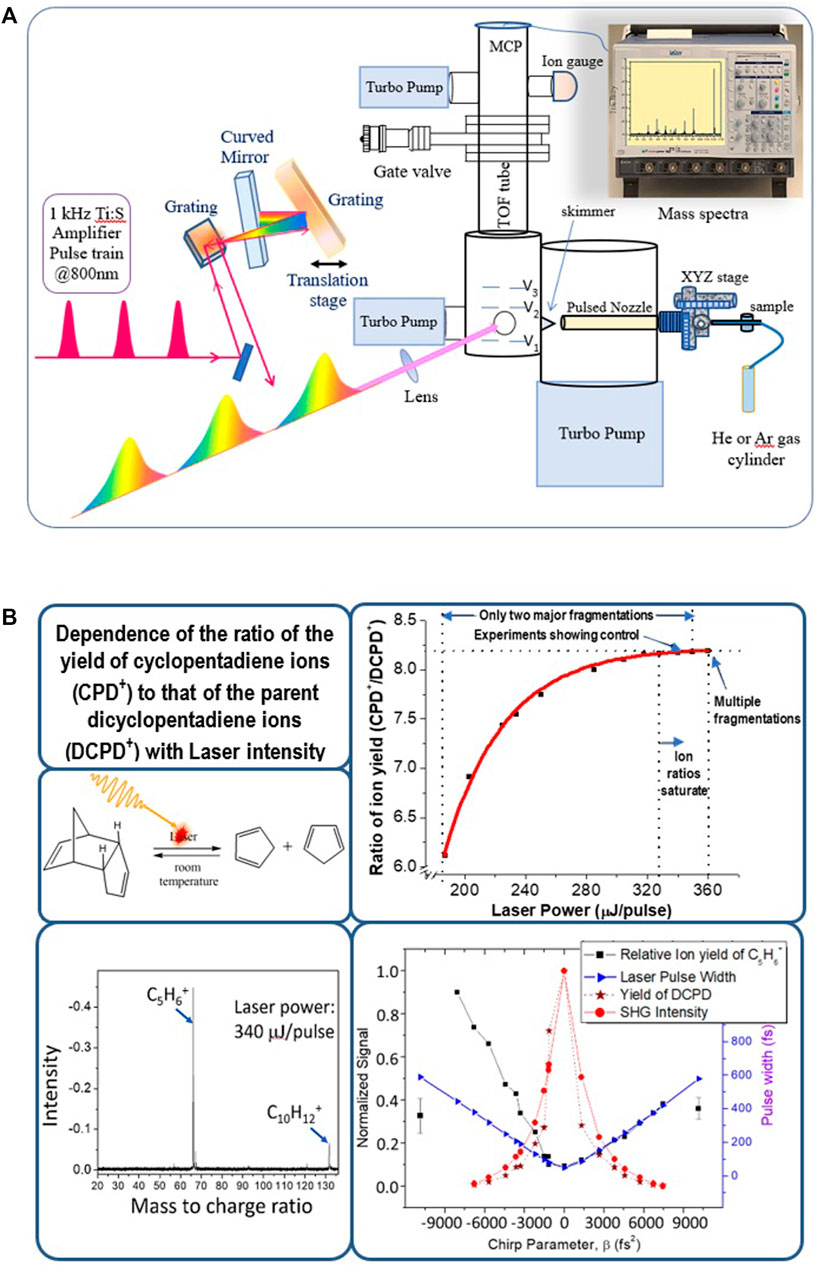
FIGURE 1. (A) Schematic diagram of control experiments with molecular beams with linearly shaped amplified laser pulses. In (B), the specific case of laser photo-fragmentation control of dicyclopentadiene is shown. The data here show that the negatively chirped laser pulses (with negative chirp parameter, β) enhance the fragmentation of dicyclopentadiene to cyclopentadiene.
A noticeable improvement in the coherent control scenario involves programmable pulse shaping with a feedback loop, which ensures that control can be attained for isolated molecules (Bergt et al., 2001). Since most individual molecular dynamics are completed within microseconds, a millisecond repetition rate is often ideal. Amplified laser pulse shaping at kHz repetition has thus flourished (Fetterman et al., 1998), and individually shaped pulses at such repetition rates have become routine (Figure 2).
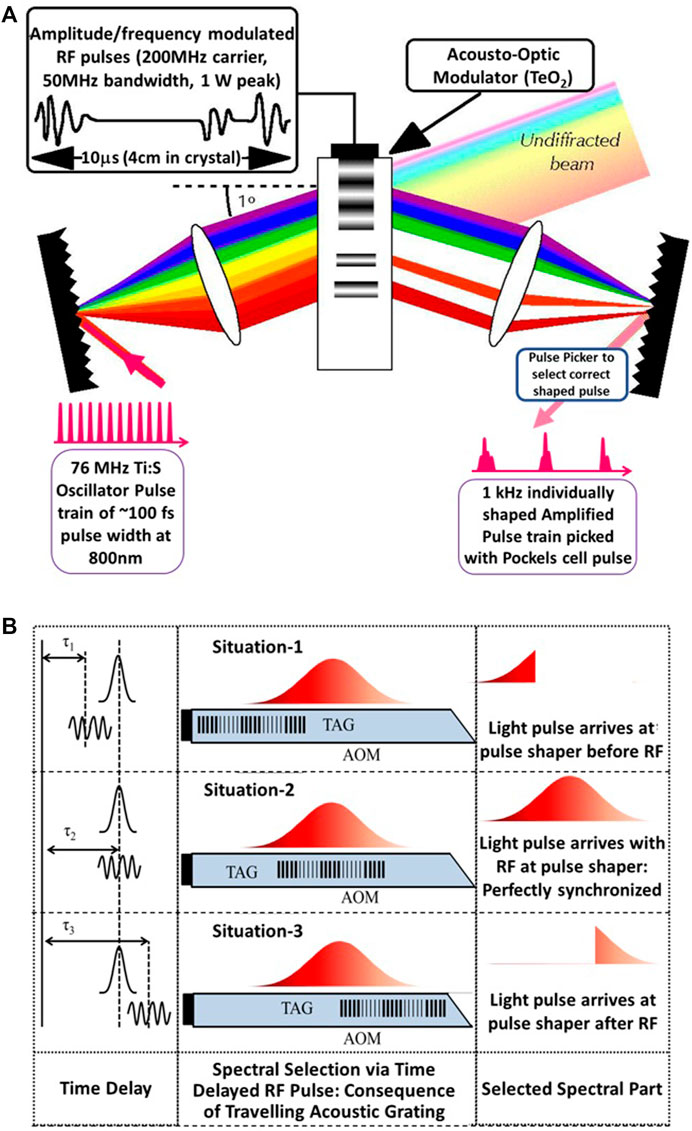
FIGURE 2. (A) Schematic of the Fourier Domain Pulse Shaping approach. For ultrashort pulses, the two lenses can be replaced with curved mirrors. (B) Low repetition rate femtosecond pulse shaping in the Fourier domain involves the selection of the desired shaped pulse, which is achieved by the Pockels Cell pulse picker in a 1 kHz amplified pulse shaping process. If needed, each pulse at 1 kHz can have a distinct shape. The control in the Fourier domain is possible by controlling the microsecond radio-frequency (RF) driving the acousto-optic modulator (AOM).
This scenario changes for the case of control in the condensed phase, where under experimental conditions, the principle of an individual isolated molecule interacting with laser cannot be applied. This is because, for condensed matter, unlike molecular beam conditions or low temperature diluted doped crystals, there is always a non-negligible statistical interaction with surrounding molecules. The focus of single-beam optical tweezers is appropriate for spatially controlling their degrees of freedom or their center of mass motion. However, to ensure the possible implementation of simultaneous temporal control, the single-beam optical tweezer setup necessitated augmentations using pulsed lasers resulting in the advancement of pulsed optical tweezers. In this context, we discuss our ultrafast pulsed laser optical tweezers developments.
As Arthur Ashkin, (1970) proposed optical tweezers with CW lasers are based on force balancing principles with the laser photon flux, which can be modeled as a Simple Harmonic Oscillator potential well, and calibrated for sensitive measurements accordingly (Ashkin and Ebrary, 2006). The scattering force on the particle can be balanced by the gradient force generated from the photon flux. Such a balance is achieved for a sharply focused Gaussian beam profile, which is the working principle behind CW optical trapping. For a pulsed laser, however, the gradient force will only be present during the pulse and not otherwise. Nevertheless, pulsed laser optical tweezers have worked reliably with high repetition rate (HRR) lasers operating at several MHz frequencies (Figure 3). This is because even the fastest possible naturally occurring process of scattering, the Brownian motion in liquids, would require about a microsecond for the particle to move away from the laser’s focal point. Thus, subsequent pulses from an HRR laser would sample the same object, and the necessary force balancing for optical tweezers remains viable. Optical tweezers are very sensitive to their immediate environments and, in fact, once calibrated, they are very effective in probing microenvironments and any changes thereof with high sensitivity (Goswami, 2015; Mondal and Goswami, 2015; Mondal et al., 2016).
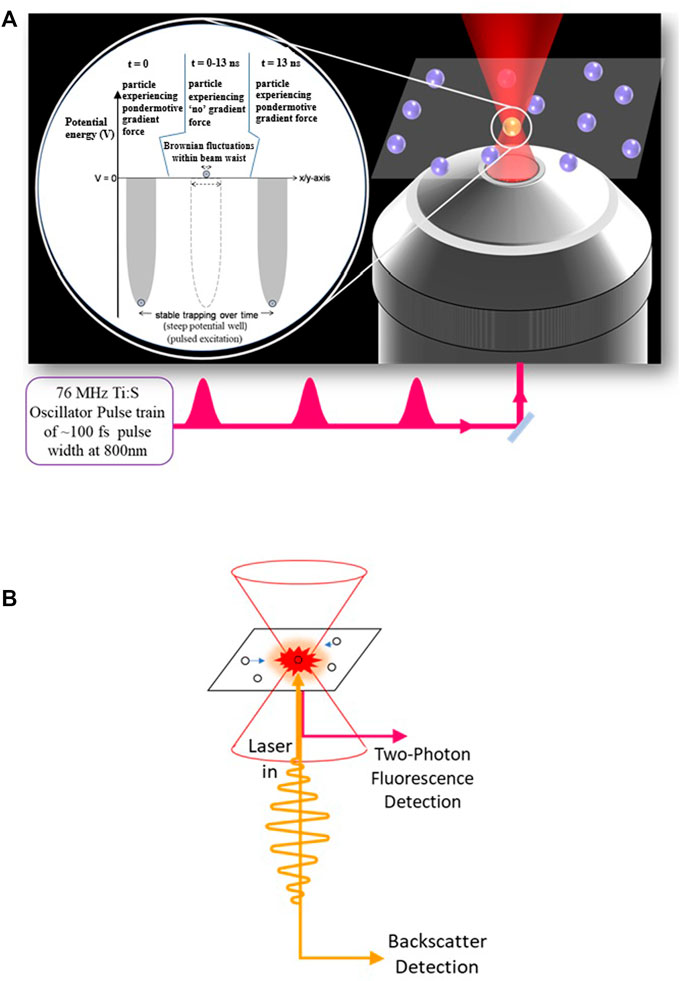
FIGURE 3. (A) Schematic diagram of the Femtosecond pulsed optical tweezers (FOT) and (B) its enhanced detection scheme due to the Two-Photon Fluorescence (TPF) detection.
An immediate advantage of using ultrashort pulses for optical tweezers lies in the capability of inducing non-linear processes that can enhance the detection of optically trapped particles through, say, the TPF effect (De et al., 2011). Enhanced detection sensitivity with TPF has also enabled the observation of smaller trapped particles because it gives rise to resolution enhancement as it is much smaller than the focusing wavelength (De and Goswami, 2011). As shown in Figure 4, this high signal-to-noise ratio (SNR) with TPF has also enabled the visualization of the optically induced aggregation effects (Mondal and Goswami, 2016; Roy et al., 2016; Roy, Mondal, and Goswami, 2016) in femtosecond optical tweezers (FOT). In fact, FOT is more optimized for Rayleigh particles that behave as point dipoles, which would be the limiting case for approaching the single-molecule domain.
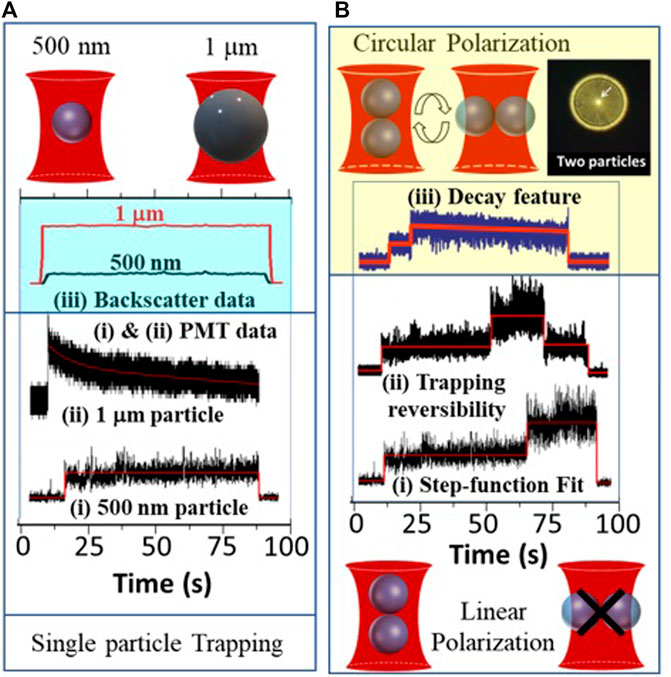
FIGURE 4. Highlighting the characteristics of FOT: (A) Size-dependent TPF signal decay in FOT as shown for (i) 500 nm versus (ii) 1-micron fluorophore-coated-bead through photo-multiplier tube (PMT) detection, which shows the importance of total versus partial illumination of the tweezed particle. (iii) Same study for backscatter data acquisition does not show any characteristic decay. Given this distinction of FOT, it can be used for determining the orientation of multiply trapped beads: (B) Use of linear versus circular polarization in the TPF data acquisition (i), (ii), and (iii) respectively, for determining the possible orientation of the two co-trapped 500 nm beads.
Another critical aspect of ultrafast pulsed optical tweezers lies in their superior management of the thermal elements of optical tweezers (Bandyopadhyay et al., 2021), which we will discuss in detail after covering the spatiotemporal aspects of the ultrafast optical tweezers. In fact, the background advancements discussed above have led us to a discussion on the development of ultrafast pulse shaping at MHz repetition rates which would be critical for implementing simultaneous temporal control with the ultrafast single-beam optical tweezer.
Most of the programmable femtosecond pulse shaping approaches are based on Fourier Transform (FT) techniques (Goswami, 2003), as femtosecond timescales are too short for direct time-domain modulations. At a kHz repetition rate, femtosecond arbitrary pulse shaping has been successfully demonstrated by selecting and amplifying the shaped pulses through an AOM (Figure 2), acting as a traveling grating in the Fourier domain (Hillegas et al., 1994). However, it is almost impossible for the HRR femtosecond lasers to generate and select a single “correct” shape through the Fourier approach alone due to the finite refresh rate and transit time of a traveling wave grating through an AOM. Fortunately, since a phase change in the Fourier domain translates to a time delay in the inverse Fourier domain, we used this approach of complex pulse shaping [both amplitude and phase modulation (Yang et al., 1998)] to demonstrate HRR femtosecond pulse shaping at MHz repetition rates. The specific demonstration is shown in Figure 5, where individually shaped pulses at ∼10-MHz repetition rates were generated that were temporarily shifted from the 76-MHz incident laser pulses from the Coherent MIRA 900F© femtosecond Ti:Sapphire laser using the Fourier delay principle (Dinda et al., 2019).
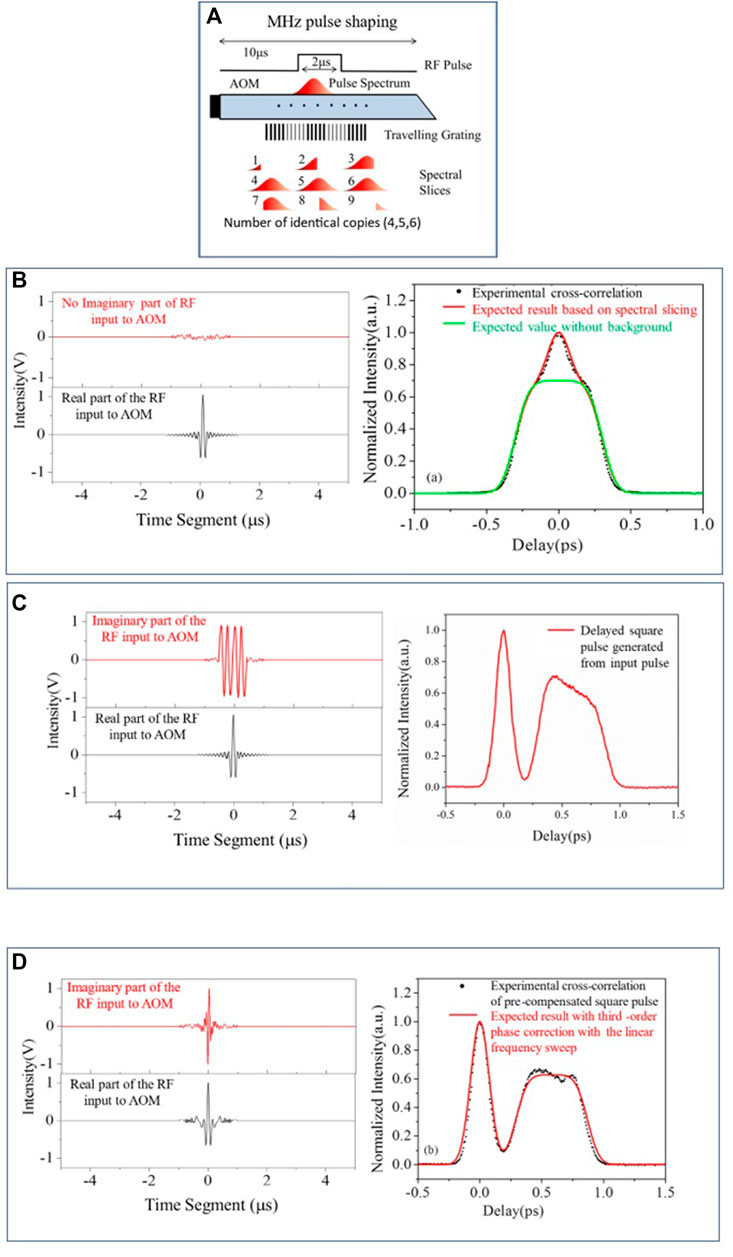
FIGURE 5. Megahertz repetition rate femtosecond pulse shaping: (A) Schematic representation showing that spectral slicing is the key in this MHz pulse shaping scheme in contrast to pulse picking for the low repetition method. (B) Since each pulse at 76 MHz cannot be shaped, there is a background of the original pulses (incident from the laser) in this pulse shaping approach. (C) Application of the Fourier phase provides the requisite time delay to separate the shaped pulses from the unshaped background. (D) Finally, distortion compensation by pre-compensating the RF by adding a third-order phase with the linear frequency sweep, which generates the correct individually shaped square pulses at ∼10 MHz.
Such MHz repetition rate pulse shaping, as shown in Figure 5, would be suitable for pulsed optical tweezers applications, as mentioned in the previous section. Given this possibility of using shaped pulse FOT, let us now revisit the theoretical aspects of FOT that arise when faced with NLO in addition to the thermal issues of optical trapping.
Thermal problems are omnipresent in optical tweezer experiments, irrespective of whether CW or pulsed lasers are generating them. In general, thermal effects for CW lasers are understood in terms of “thermal lens” generation due to changes in the refractive index arising from the thermally induced heat load (Català et al., 2017). Most systems expand on heating. As a consequence, a reduction of the refractive index occurs. Thus, the thermal lens (TL) is primarily a diverging lens. Due to the high disparity in timescales for a single femtosecond laser pulse, the thermal effect is insignificant. However, for HHR femtosecond lasers, which is the requirement for, say, an optical tweezer, cumulative thermal effects occur as well (Singh et al., 2021). Additionally, the use of femtosecond pulses for optical trapping also invokes NLO processes. Much of the NLO effect induced is a result of the Kerr non-linearity. Interestingly, ultrafast-laser-induced non-linearities can offset thermal effects in femtosecond optical tweezers since the refractive index changes due to TL and the ones due to the Kerr effect have opposite signs for many systems over varying conditions for the laser parameters (Goswami, 2021). This result is of significant benefit (Figure 6) as it is an important aspect of control that can be achieved through the manipulation of several light-matter interactions depending on the tweezing particle’s size and environment as well as the tweezer laser’s characteristics like its beam size and shape, laser pulse width, center wavelength, phase, etc., As shown in Figure 6, we define an important parameter in this context, the “escape potential,” which can effectively be used to quantify the stability of the optical trap.
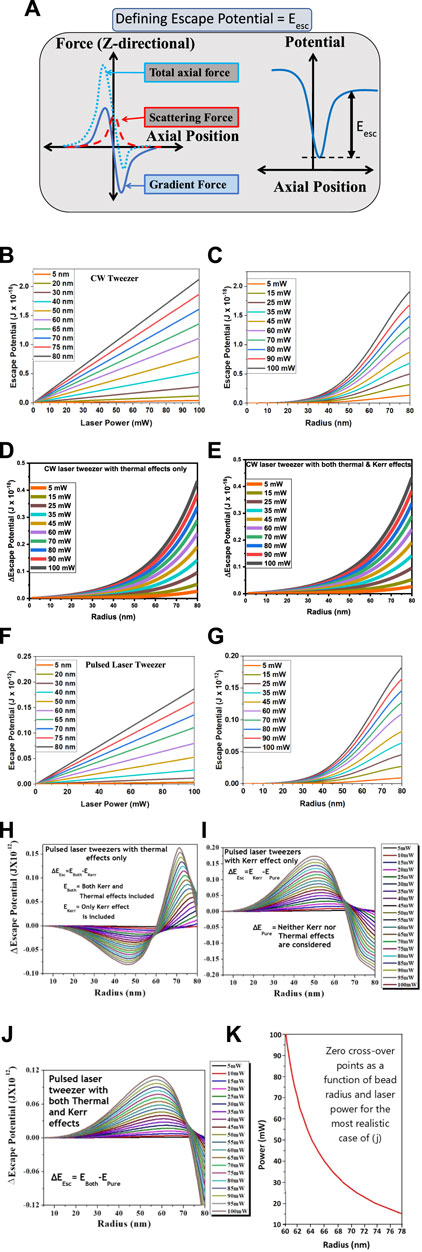
FIGURE 6. A theoretical model of optical tweezers for both CW and pulsed lasers: (A) Schematic of the force balancing used for the calculations. For CW tweezers, as shown in (B), the calculated escape potentials scale linearly with increasing laser powers, which also depends on the trapped bead radius. However, as shown in (C), the trapped bead radius dependence on the calculated escape potentials is not linear. A more useful approach is to use the difference in the escape potentials for (D) thermal effects only and (E) both thermal and Kerr effects, compared to the case with neither effect present. Note that (D) and (E) is essentially the same since the Kerr effect is not induced with CW lasers. For pulsed tweezers, (F) the calculated escape potentials are about 5-orders in magnitude higher due to high peak powers and still scale linearly with increasing laser powers. (G) For the simplest case without any thermal or Kerr effect, the bead radius dependence on the calculated escape potentials is also like that of the CW laser case except for the higher magnitude. However, the dependence of trapping bead radius on the difference in the escape potentials looks much more complicated with (H) only the Kerr effect and with (I) only the thermal effect compared to the cases when neither effect is incorporated. (J) We also have the distinct case where both thermal and Kerr effects are present, which is the most realistic case for femtosecond pulsed laser optical tweezers. (K) Finally, since the thermal and Kerr effects often impact in opposite ways on non-linear refractive index, they can balance each other as a function of trapping bead radius.
A further important aspect of this pragmatic developmental approach to control is that it does not ignore or oversimplify the practical ubiquity of thermal effects, which also interfere with NLO measurements; this is evident from the discussion above. There have been multiple attempts to minimize or avoid thermal effects with varying levels of success (Singhal et al., 2017; Maurya et al., 2019). Interestingly, FOT can also measure with high precision at micron resolution the impact of laser-induced thermal effects that result in temperature and viscosity changes (Mondal, Mathur, Goswami, 2016). For studying a perfectly uniform system, it is best to use a sufficiently rapid moving or flowing design to circumvent thermal effects by effectively regenerating the sample. However, the most important fallout of this recognition of thermal effects, even with femtosecond lasers at HRR, is perhaps the development of femtosecond thermal lens spectroscopy (FTLS) (Bhattacharyya et al., 2010), which we will discuss next.
In general, thermal effects always interfere with the measurement process. However, there are circumstances like the one presented in the previous section where thermal effects may be beneficial to offset NLO effects in femtosecond optical tweezers. Similarly, FTLS has been developed and proven to be an incredibly versatile technique (Bhattacharyya et al., 2010; Singhal and Goswami, 2019). Though each femtosecond laser pulse provides an almost negligible energy load to the sample, the cumulative effect of HRR femtosecond pulses results in a significant thermal load (Kumar et al., 2014). Such an accumulative effect with minuscule heating capability is even suitable for highly volatile systems and a smooth transition into out-of-equilibrium conditions without other delirious effects under reasonable experimental conditions (Kumar et al., 2014). The heat load generated is maximum at the center of the beam resulting in a temperature gradient leading to the creation of a refractive index gradient and results in the “thermal lens,” a lens-like optical element in the sample (Leite et al., 1964; Roess, 1966; Osterink and Foster, 1968; Foster and Osterink, 1970). Subsequently, various heat dissipation dynamics arise, viz., thermal conduction, convection, and radiative relaxation, all of which work together to equilibrate the heat generated in the sample. Amongst these, thermal convection plays a significant role for fluids primarily associated with molecular movement and is, thus, found to be strongly correlated to molecular properties. Previous studies involving continuous irradiation focused on thermal effects of small magnitudes, where it sufficed only to consider the conductive dissipation effects (Shen et al., 1992; Shen et al., 1995; Marcano et al., 2002; Marcano et al., 2006) to be able to derive exhibited phenomenological and bulk characteristics. The inclusion of thermal convection for ultrafast laser thermal processes, which correlates with molecular properties, has driven the development of ultrafast laser-induced thermal processes for sensitive spectroscopy (Figure 7, 8). Figure 7 represents the dual beam high repetition rate experimental setup where both the steady-state and time-resolved experiments can be carried out.
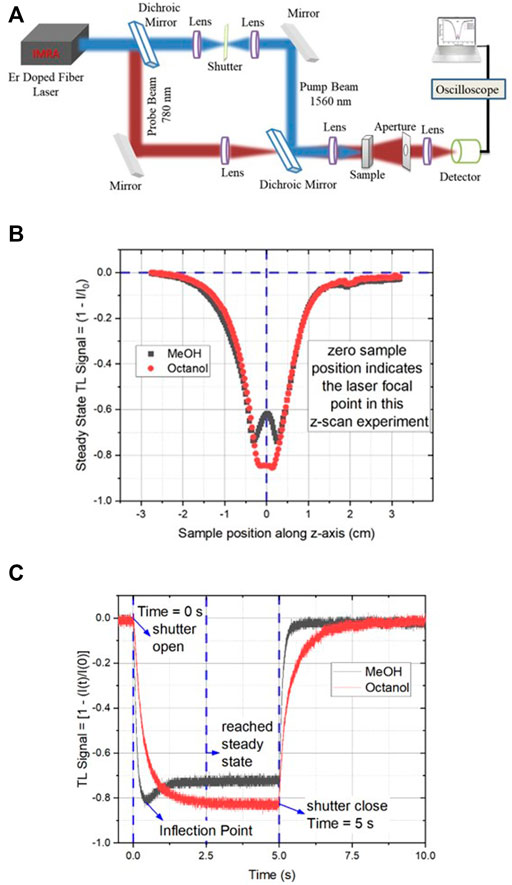
FIGURE 7. Femtosecond thermal lens (TL) spectroscopy with dual laser beams: (A) Experimental setup for both stationary as well as time-resolved TL measurements with high-repetition-rate lasers in a dual-beam experimental configuration. (B) Typical steady-state TL signals for dual-beam experiments for two different samples were collected as a function of sample position across the focal point of the TL-inducing laser. Drastic molecular dependence of TL is evident between methanol and octanol. (C) The corresponding time-resolved TL signal shows the molecular distinction in femtosecond TL. The inflection point indicates the importance of convection effects in addition to the conduction models that are molecule insensitive.
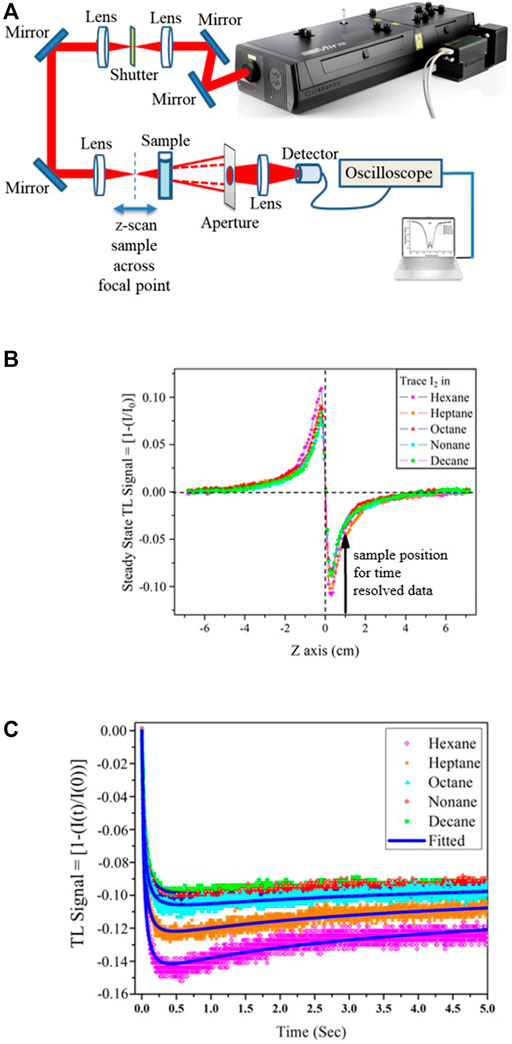
FIGURE 8. Femtosecond thermal lens (TL) spectroscopy with single laser beam: (A) Experimental setup for both stationary as well as time-resolved single beam femtosecond TL studies. (B) Typical steady-state TL signals for single-beam experiments as a function of sample position across the focal point of the TL-inducing laser for various samples showing zero-crossing at the focal point. For time-resolved TL collection, a position other than the focal point indicated by the arrow is chosen. (C) Time-resolved TL signals for Single beam femtosecond TL studies for the same shutter opening window. The early-time diagnostics of the shutter open part shows the importance of early time versus steady state. Note that for alkane samples, where the thermal effect is low, I2 was added to keep the extent of TL generation steady across different samples. Fitting of the data is possible with Eq. 2, as discussed in the text.
The experimental data collected can be effectively modeled and fitted by understanding the temperature distribution in space and time created as a result of the excitation laser heat deposition and dissipation. The uniqueness of the FTLS lies in the cumulative nature of the heat deposition process, as discussed.
A single laser beam high repetition rate experimental setup with high sensitivity has, in fact, also been established (Figure 8), where both the steady-state and time-resolved experiments can be carried out (Singhal and Goswami, 2020). The crucial aspect in the experimental design of the single beam technique (Figure 8A) lies in realizing that the stationary sample position for time-resolved measurements cannot be the focal point of the TL-generating laser. This is because there is no TL signal at the focus, so we choose the stationary sample position for time-resolved measurements as indicated by an arrow in Figure 8B, which is quite unlike the dual beam setup.
The TL model that includes both the conduction and convection terms involves a coupled differential equation that can be solved using the dimensionless parameter known as the Peclet number,
where, D is the thermal diffusivity and vx is the convection velocity through the region of investigation. This can result in the TL fitting model that uses both conduction and convection (Singhal and Goswami, 2020):
The real nature of the TL signal arises from the mod square as shown in the above complex expression involving:
When
Most literature involving the Shen model has a very low heat load. Therefore, the first term of Eq. 3 suffices, which can then be reduced to the popular mathematical expression for the Shen model (Shen et al., 1992; Shen et al., 1995) given by:
Thus, FTLS can distinguish between molecules within fluids based on both size and shape (Kumar et al., 2014; Kumar et al., 2014). Similarly, the differentiation of isomers and isotopes in fluids is also effectively possible with FTLS (Bhattacharyya et al., 2014; Kumar et al., 2014). Additionally, FTLS is also sensitive to changes in intermolecular interactions, which would lead to phase separations (Goswami et al., 2019), interfaces (Singhal and Goswami, 2020), and several other physical interactions (Maurya et al., 2016; Rawat et al., 2021). Cumulative thermal processes fall in the domain of weak perturbations that do not require strong absorption or any exact resonant excitation conditions. Consequently, they work over a broad range of wavelengths as well as laser pulse widths. Thus, FTLS is an astoundingly versatile technique (Goswami et al., 2021), which is continuously being unveiled to date.
We have presented the pragmatic aspect of intense laser-induced light-matter control that can circumvent practical experimental constraints. The concept of spatiotemporal control that simultaneously manipulates the position and time dynamics has been discussed in the context of femtosecond optical trapping and is further enabled through the Megahertz repetition rate femtosecond pulse shaping. While the presence of non-linear interactions with femtosecond lasers has been shown to offset the omnipresent thermal effects in optical tweezers, it has also been shown to attain a better signal-to-noise ratio through two-photon fluorescence detection of trapping. As an additional outcome, we have demonstrated how the omnipresent thermal effects can be turned around for cumulatively accumulating minuscule femtosecond induced heat load into an interesting femtosecond laser thermal lens setup for Megahertz repetition rate femtosecond lasers and provide sensitive molecular detection. Such developments in spatiotemporal control with intense femtosecond optical pulse shaping approaches thus promise myriad applications with continuous advancements.
The original contributions presented in the study are included in the article/Supplementary Material, further inquiries can be directed to the corresponding author.
The author confirms being the sole contributor of this work and has approved it for publication.
The author acknowledges the funding support of this research from MEITY, SERB, STC ISRO of the Govt. of India as well as IIT Kanpur for all the infrastructure support.
The author thanks all his present and past students for their hard work over the years, enabling the present state-of-the-art experiments and explorations possible. The author is also highly thankful to S. Goswami for proofreading, language correction, and editing.
The authors declare that the research was conducted in the absence of any commercial or financial relationships that could be construed as a potential conflict of interest.
All claims expressed in this article are solely those of the authors and do not necessarily represent those of their affiliated organizations, or those of the publisher, the editors and the reviewers. Any product that may be evaluated in this article, or claim that may be made by its manufacturer, is not guaranteed or endorsed by the publisher.
Aeschlimann, M., Bauer, M., Bayer, D., Brixner, T., Cunovic, S., Dimler, F., et al. (2010). Spatiotemporal control of nanooptical excitations. Proc. Natl. Acad. Sci. 107 (12), 5329–5333. doi:10.1073/pnas.0913556107
Arnold, F. H. (2017). Directed evolution: Bringing new chemistry to life. Angew. Chem. Int. Ed. 57 (16), 4143–4148. doi:10.1002/anie.201708408
Ashkin, A. (1970). Acceleration and trapping of particles by radiation pressure. Phys. Rev. Lett. 24 (4), 156–159. doi:10.1103/physrevlett.24.156
Ashkin, A., and Ebrary, I. (2006). Optical trapping and manipulation of neutral particles using lasers. Hackensack, NJ, USA: World Scientific.
Bandyopadhyay, S. N., Gaur, T., and Goswami, D. (2021). Comparative study of the real-time optical trapping in the Rayleigh regime for continuous and femtosecond pulsed lasers. Opt. Laser Technol. 136, 106770. doi:10.1016/j.optlastec.2020.106770
Bergman, T. L. (2019). Fundamentals of heat and mass transfer, wileyplus blackboard card S L. Hoboken, NJ, USA: John Wiley.
Bergt, M., Brixner, T., Kiefer, B., Strehle, M., and Gerber, G. (2001). Control of quantum dynamics by adaptive femtosecond pulse shaping. Ultrafast Phenom. 12, 19–23. doi:10.1007/978-3-642-56546-5_4
Bhattacharyya, I., Kumar, P., and Goswami, D. (2014). Effect of isotope substitution in binary liquids with Thermal-Lens spectroscopy. Chem. Phys. Lett. 598, 35–38. doi:10.1016/j.cplett.2014.02.056
Bhattacharyya, I., Kumar, P., and Goswami, D. (2010). Probing intermolecular interaction through thermal-lens spectroscopy. J. Phys. Chem. B 115 (2), 262–268. doi:10.1021/jp1062429
Català, F., Marsà, F., Montes-Usategui, M., Farré, A., and Martín-Badosa, E. (2017). Influence of experimental parameters on the laser heating of an optical trap. Sci. Rep. 7 (1), 16052. doi:10.1038/s41598-017-15904-6
Dantus, M., and Lozovoy, V. V. (2004). Experimental coherent laser control of physicochemical processes. Chem. Rev. 104 (4), 1813–1860. doi:10.1021/cr020668r
De, A. K., and Goswami, D. (2011). Towards controlling molecular motions in fluorescence microscopy and optical trapping: A spatiotemporal approach. Int. Rev. Phys. Chem. 30 (3), 275–299. doi:10.1080/0144235x.2011.603237
De, A. K., Roy, D., Dutta, A., and Goswami, D. (2009). Stable optical trapping of latex nanoparticles with ultrashort pulsed illumination. Appl. Opt. 48 (31), G33. doi:10.1364/ao.48.000g33
De, A. K., Roy, D., and Goswami, D. (2011). Two-photon fluorescence diagnostics of femtosecond laser tweezers. Curr. Sci. 101 (7), 935–945. https://www.jstor.org/stable/24079130.
de Vivie-Riedle, R., Kurtz, L., and Hofmann, A. (2001). Coherent control for ultrafast photochemical reactions. Pure Appl. Chem. 73 (3), 525–528. doi:10.1351/pac200173030525
Dinda, S., Bandyopadhyay, S. N., and Goswami, D. (2019). Rapid programmable pulse shaping of femtosecond pulses at the MHz repetition rate. OSA Contin. 2 (4), 1386. doi:10.1364/osac.2.001386
Fetterman, M. R., Goswami, D., Keusters, D., Yang, W., Rhee, J.-K., and Warren, W. S. (1998). Ultrafast pulse shaping: Amplification and characterization. Opt. Express 3 (10), 366. doi:10.1364/oe.3.000366
Foster, J. D., and Osterink, L. M. (1970). Thermal effects in a Nd:YAG laser. J. Appl. Phys. 41 (9), 3656–3663. doi:10.1063/1.1659488
Froula, D. H., Turnbull, D., Davies, A. S., Kessler, T. J., Haberberger, D., Palastro, J. P., et al. (2018). Spatiotemporal control of laser intensity. Nat. Photonics 12 (5), 262–265. doi:10.1038/s41566-018-0121-8
Goswami, D. “Demonstrating a nano viscometer using femtosecond laser induced photo-thermal effect,” in Proceedings of the 2015 Workshop on Recent Advances in Photonics (WRAP), Bangalore, India, December 2015. doi:10.1109/wrap.2015.7806018
Goswami, D. (2003). Optical pulse shaping approaches to coherent control. Phys. Rep. 374 (6), 385–481. doi:10.1016/s0370-1573(02)00480-5
Goswami, D. (2021). Understanding femtosecond optical tweezers: The critical role of nonlinear interactions. J. Phys. Conf. Ser. 1919 (1), 012013. doi:10.1088/1742-6596/1919/1/012013
Goswami, S., Singhal, S., Banerjee, A., and Goswami, D. “Sensitive detection of phase separation with femtosecond thermal lens spectroscopy,” in Proceedings of the 2019 Workshop on Recent Advances in Photonics (WRAP), Guwahati, India, December 2019. doi:10.1109/wrap47485.2019.9013833
Goswami, S., Singhal, S., and Goswami, D. (2021). “Detecting in-situ phase separation with Femtosecond thermal lens spectroscopy to map COVID-19 transmission,” OSA Optical Sensors and Sensing Congress 2021 (AIS, FTS, HISE, SENSORS, ES). Editor S. Buckley, F. Vanier, K. Shi, I. Walker, S. Coddington, S. Paineet al. (OSA Technical Digest (Optica Publishing Group, 2021)). paper AM2D.6
Goswami, T., Das, D. K., and Goswami, D. (2013). Controlling the femtosecond laser-driven transformation of dicyclopentadiene into cyclopentadiene. Chem. Phys. Lett. 558, 1–7. doi:10.1016/j.cplett.2012.10.054
Hikosaka, Y., Kaneyasu, T., Fujimoto, M., Iwayama, H., and Katoh, M. (2019). Coherent control in the extreme ultraviolet and attosecond regime by synchrotron radiation. Nat. Commun. 10 (1), 4988. doi:10.1038/s41467-019-12978-w
Hillegas, C. W., Tull, J. X., Goswami, D., Strickland, D., and Warren, W. S. (1994). Femtosecond laser pulse shaping by use of microsecond radio-frequency pulses. Opt. Lett. 19 (10), 737. doi:10.1364/ol.19.000737
Kumar, P., Dinda, S., Chakraborty, A., and Goswami, D. (2014). Unusual behavior of thermal lens in alcohols. Phys. Chem. Chem. Phys. 16 (24), 12291–12298. doi:10.1039/c4cp00895b
Kumar, P., Dinda, S., and Goswami, D. (2014). Effect of molecular structural isomers in thermal lens spectroscopy. Chem. Phys. Lett. 601, 163–167. doi:10.1016/j.cplett.2014.03.095
Kumar, P., and Goswami, D. (2014). Importance of molecular structure on the thermophoresis of binary mixtures. J. Phys. Chem. B 118, 14852–14859. doi:10.1021/jp5079604
Kumar, P., Khan, A., and Goswami, D. (2014). Importance of molecular heat convection in time resolved thermal lens study of highly absorbing samples. Chem. Phys. 441, 5–10. doi:10.1016/j.chemphys.2014.06.008
Leite, R. C. C., Moore, R. S., and Whinnery, J. R. (1964). Low absorption measurements by means of the thermal lens effect using an He–Ne laser. Appl. Phys. Lett. 5 (7), 141–143. doi:10.1063/1.1754089
Marcano, A., Cabrera, H., Guerra, M., Cruz, R. A., Jacinto, C., and Catunda, T. (2006). Optimizing and calibrating a mode-mismatched thermal lens experiment for low absorption measurement. J. Opt. Soc. Am. B 23 (7), 1408. doi:10.1364/josab.23.001408
Marcano, A., Loper, C., and Melikechi, N. (2002). Pump–probe mode-mismatched thermal-lens Z scan. J. Opt. Soc. Am. B 19 (1), 119. doi:10.1364/josab.19.000119
Maurya, S. K., Das, D., and Goswami, D. (2016). Probing intermolecular interactions in binary liquid mixtures using femtosecond laser-induced self-defocusing. Appl. Spectrosc. 70 (10), 1655–1661. doi:10.1177/0003702816643547
Maurya, S. K., Yadav, D., and Goswami, D. (2019). Effect of femtosecond laser pulse repetition rate on nonlinear optical properties of organic liquids. PeerJ Phys. Chem. 1, e1. doi:10.7717/peerj-pchem.1
Melinger, J. S., Gandhi, S. R., Hariharan, A., Goswami, D., and Warren, W. S. (1994). Adiabatic population transfer with frequency swept laser pulses. J. Chem. Phys. 101 (8), 6439–6454. doi:10.1063/1.468368
Mondal, D., and Goswami, D. (2016). Controlling and tracking of colloidal nanostructures through two-photon fluorescence. Methods Appl. Fluoresc. 4 (4), 044004. doi:10.1088/2050-6120/4/4/044004
Mondal, D., and Goswami, D. (2015). Controlling local temperature in water using femtosecond optical tweezer. Biomed. Opt. Express 6 (9), 3190. doi:10.1364/boe.6.003190
Mondal, D., Mathur, P., and Goswami, D. (2016). Precise control and measurement of solid–liquid interfacial temperature and viscosity using dual-beam femtosecond optical tweezers in the condensed phase. Phys. Chem. Chem. Phys. 18 (37), 25823–25830. doi:10.1039/c6cp03093a
Osterink, L. M., and Foster, J. D. (1968). Thermal effects and transverse mode control in a Nd:YAG laser. Appl. Phys. Lett. 12 (4), 128–131. doi:10.1063/1.1651922
Rawat, A. K., Chakraborty, S., Mishra, A. K., and Goswami, D. (2021). Unraveling molecular interactions in binary liquid mixtures with time-resolved thermal-lens-spectroscopy. J. Mol. Liq. 336, 116322. doi:10.1016/j.molliq.2021.116322
Rice, Stuart Alan, and Zhao, Meishan (2000). Optical control of molecular dynamics. New York, NY, USA: John Wiley.
Roess, D. (1966). Analysis of a room temperature cw ruby laser of 10 mm resonator length: The ruby laser as a thermal lens. J. Appl. Phys. 37 (9), 3587–3594. doi:10.1063/1.1708908
Roy, D., Mondal, D., and Goswami, D. (2016). Structure and dynamics of optically directed self-assembly of nanoparticles. Sci. Rep. 6 (1), 23318. doi:10.1038/srep23318
Roy, D., Mondal, D., and Goswami, D. (2016). Two-photon fluorescence tracking of colloidal clusters. J. Fluoresc. 26 (4), 1271–1277. doi:10.1007/s10895-016-1814-3
Schmidt, R., Weihs, T., Wurm, C. A., Jansen, I., Rehman, J., Sahl, S. J., et al. (2021). MINFLUX nanometer-scale 3D imaging and microsecond-range tracking on a common fluorescence microscope. Nat. Commun. 12 (1), 1478. doi:10.1038/s41467-021-21652-z
Sheldon, S. J., Knight, L. V., and Thorne, J. M. (1982). Laser-induced thermal lens effect: A new theoretical model. Appl. Opt. 21 (9), 1663. doi:10.1364/ao.21.001663
Shen, J., Lowe, R. D., and Snook, R. D. (1992). A model for cw laser induced mode-mismatched dual-beam thermal lens spectrometry. Chem. Phys. 165 (2-3), 385–396. doi:10.1016/0301-0104(92)87053-c
Shen, J., Soroka, A. J., and Snook, R. D. (1995). A model for cw laser induced mode mismatched dual beam thermal lens spectrometry based on probe beam profile image detection. J. Appl. Phys. 78 (2), 700–708. doi:10.1063/1.360329
Singh, A., Bandyopadhyay, S. N., Singh, K. K., Kumar, D., and Goswami, D. “Experimental comparison of conventional and femtosecond optical tweezers,” in Proceeding of the 2021Conference on Lasers and Electro-Optics, San Jose, CA, USA, May 2021. doi:10.1364/cleo_at.2021.jw1a.153
Singhal, S., Dinda, S., and Goswami, D. (2017). Measurement of pure optical nonlinearity in carbon disulfide with a high-repetition-rate femtosecond laser. Appl. Opt. 56 (3), 644. doi:10.1364/ao.56.000644
Singhal, S., and Goswami, D. (2019). Thermal lens study of NIR femtosecond laser-induced convection in alcohols. ACS Omega 4 (1), 1889–1896. doi:10.1021/acsomega.8b02956
Singhal, S., and Goswami, D. (2020). Unraveling the molecular dependence of femtosecond laser-induced thermal lens spectroscopy in fluids. Analyst 145 (3), 929–938. doi:10.1039/c9an01082c
Warren, W. S., Rabitz, H., and Dahleh, M. (1993). Coherent control of quantum dynamics: The dream is alive. Science 259 (5101), 1581–1589. doi:10.1126/science.259.5101.1581
Keywords: femtosecond pulse shaping, pulsed optical tweezers, coherent control, kerr effect, thermal lens spectroscopy, convection, microheterogeneity, interface
Citation: Goswami D (2023) Intense femtosecond optical pulse shaping approaches to spatiotemporal control. Front. Chem. 10:1006637. doi: 10.3389/fchem.2022.1006637
Received: 29 July 2022; Accepted: 28 December 2022;
Published: 12 January 2023.
Edited by:
Yuichi Fujimura, Tohoku University, JapanReviewed by:
Tomoyuki Endo, National Institues for Quantum and Radiological Science and Technology (QST), JapanCopyright © 2023 Goswami. This is an open-access article distributed under the terms of the Creative Commons Attribution License (CC BY). The use, distribution or reproduction in other forums is permitted, provided the original author(s) and the copyright owner(s) are credited and that the original publication in this journal is cited, in accordance with accepted academic practice. No use, distribution or reproduction is permitted which does not comply with these terms.
*Correspondence: Debabrata Goswami, ZGdvc3dhbWlAaWl0ay5hYy5pbg==
Disclaimer: All claims expressed in this article are solely those of the authors and do not necessarily represent those of their affiliated organizations, or those of the publisher, the editors and the reviewers. Any product that may be evaluated in this article or claim that may be made by its manufacturer is not guaranteed or endorsed by the publisher.
Research integrity at Frontiers

Learn more about the work of our research integrity team to safeguard the quality of each article we publish.